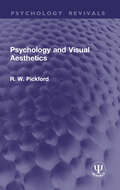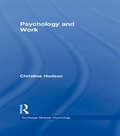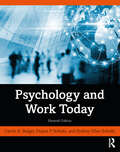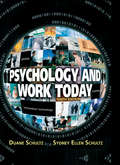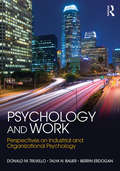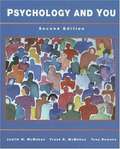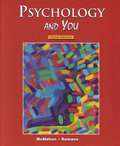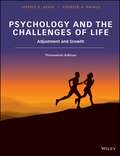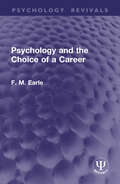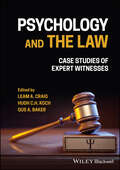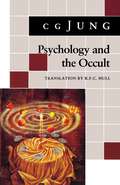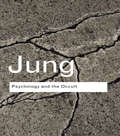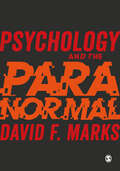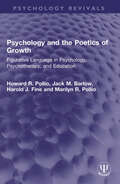- Table View
- List View
Psychology and Visual Aesthetics (Psychology Revivals)
by R. W. PickfordOriginally published in 1972, the aim of Psychology and Visual Aesthetics was to present a study mainly concerned with experimental work on visual aesthetics. From the rather restricted approaches of Fechner, the pioneer of experimental aesthetics, whose book Vorschule der Aesthetik was published in 1876, there had been a spread of interest out of the confines of the psychological laboratory to statistical studies, personality problems and social psychology. Although not a history of experimental aesthetics is was hoped that the various phases of development would be apparent, as follows: at first laboratory studies, mainly on individuals; then statistically oriented studies with numbers of subjects; in the 1940s the beginnings of the mathematical analysis of aesthetic judgments; then the introduction of personality studies, including the problems of the aesthetic judgments of psychiatric patients; and in the 1950s and 1960s the development of studies based on social psychology and the cross-cultural approaches.These changes had taken place, hand in hand with developments in psychology as a whole and of psychological techniques, as will be evident in the chapters that follow. The changes correspond to the successive developments of Fechnerian experimental work, then of Gestalt Psychology, then intelligence tests and tests of special capacities and abilities, then personality tests and the understanding of abnormal psychology, and finally the expansion of research into what was now often called experimental social psychology. Today it can be read in its historical context.This book is a re-issue originally published in 1972. The language used is a reflection of its era and no offence is meant by the Publishers to any reader by this re-publication.
Psychology and Western Religion: (From Vols. 11, 18 Collected Works) (Bollingen Series (General) #653)
by C. G. JungExtracted from Volumes 11 and 18. This selection of Jung's writings brings together a number of articles that are necessary for the understanding of his interpretation of the religious life and development of Western man: views that are central to his psychological thought.
Psychology and Work (Routledge Modular Psychology)
by Christine HodsonPsychology and Work provides a concise, user-friendly introduction to the field of occupational psychology. The book covers the main issues in the psychology of work and organizations. Topics discussed include the significance of work to the individual, the motivation to work, selection and training and the effects of work on health and quality of life. Organizational psychology is covered in such topics as group behaviour, leadership and management. The book assumes little or no background knowledge and is made accessible to all by the use of everyday examples throughout.Christine Hodson has produced an ideal text, designed for A Level students and undergraduates of psychology plus business studies new to this field.
Psychology and Work Today
by Duane P. Schultz Sydney Ellen Schultz Carrie A. BulgerPsychology and Work Today, 11th Edition is an exciting update of a well-loved textbook that introduces industrial and organizational psychology, explaining how industrial-organizational psychologists make work and working better. This accessible and informative text explains how industrial-organizational psychologists help organizations hire the best people by designing tests and interviews that uncover the skills and abilities of applicants, make work better by removing or reducing safety issues and sources of stress so that personnel are motivated and able to perform to their abilities, and work with managers and leaders to be more effective at leading others. This book also describes how industrial-organizational psychologists work with organizations to embrace diversity in the workforce and celebrate the strengths that employees from many backgrounds bring to organizations. In addition, this text includes how psychologists help organizations to design the physical work environment to best suit employees, while other psychologists help organizations to market their products and services to consumers. This text covers both the essential and traditional industrial-organizational psychology topic areas such as job analysis, employee selection, and work motivation as well as topic areas that are important in workplaces today such as stress and well-being, human factors, and preparing for jobs of the future. The chapter on consumer psychology remains unique to this textbook. This new edition includes coverage of employable skills desired by hiring managers and executives; the ways the highly publicized replicability crisis has affected the science and practice of industrial-organizational psychology; online and mobile employment testing; diversity and inclusion throughout the workplace, including microaggressions; preparing people and organizations for jobs of the future; incivility and harassment at work, including abusive supervision; safety climate and employee health; and advertising on social media and video games. Including many illustrative examples of industrial-organizational psychology in real-world workplaces, the 11th Edition is thoroughly updated to include the latest theory, research, and practice on each key topic. Each chapter features defined key terms, a chapter outline, a chapter summary, review questions, annotated additional reading, and engaging Newsbreak sections. The book will be of interest to undergraduate students in introduction industrial-organizational psychology or psychology of work behaviour courses.
Psychology and Work Today
by Carrie A. Bulger Duane P. Schultz Sydney Ellen SchultzThis key textbook introduces students to the field of industrial and organizational psychology, explaining how industrial-organizational psychologists make work and working better. It explains how industrial-organizational psychologists help organizations hire the best people, make work safer and less stressful, and support managers and leaders to be more effective at leading others. It also describes how industrial-organizational psychologists work with organizations to embrace diversity in the workforce, design the physical work environment to best suit employees, and market their products and services to consumers.Key features of this edition include: Coverage of both the essential and traditional I-O topic areas such as job analysis, employee selection, and work motivation, as well as topic areas that are important in workplaces today such as stress and well-being, human factors, and preparing for jobs of the future. New or expanded coverage of teams in organizations, remote/hybrid work, quiet quitting, and diversity, equity, and inclusion issues, A streamlined methods chapter that focuses more on specific methods used by industrial-organizational psychologists, such as focus groups, surveys, and Gallup polls. Rich with various pedagogical tools and real-world examples, the book will be of interest to undergraduate students in introduction industrial-organizational psychology or psychology of work behaviour courses.
Psychology and Work Today, 10th Edition
by Duane P. Schultz Sydney Ellen SchultzFor undergraduate-level courses in Industrial and Organizational Psychology, Business Psychology, Personnel Psychology and Applied Psychology. Psychology and Work Today provides an invaluable foundation for anyone entering today's global business and industrial world. This informative, sophisticated, and entertaining text teaches students about the nature of work in modern society. By focusing on the practical and applied rather than the scientific ideal, the authors demonstrate how industrial-organizational psychology directly impacts our lives as job applicants, trainees, employees, managers, and consumers.
Psychology and Work Today: Pearson New International Edition CourseSmart eTextbook
by Duane Schultz Sydney Ellen SchultzFor undergraduate-level courses in Industrial and Organizational Psychology, Business Psychology, Personnel Psychology and Applied Psychology. Psychology and Work Today provides an invaluable foundation for anyone entering today's global business and industrial world. This informative, sophisticated, and entertaining text teaches students about the nature of work in modern society. By focusing on the practical and applied rather than the scientific ideal, the authors demonstrate how industrial-organizational psychology directly impacts our lives as job applicants, trainees, employees, managers, and consumers.
Psychology and Work: An Introduction to Industrial and Organizational Psychology
by Berrin Erdogan Donald M. Truxillo Talya N. BauerPsychology and Work is a new edition of the award-winning textbook written for introductory Industrial and Organizational (I-O) Psychology classes. This book makes the core topics of I-O Psychology clear, relevant, and accessible to students through its dynamic design. The real-world examples from the perspectives of employees and employers highlight how I-O Psychology is applied to today’s workplace. Psychology and Work, Second Edition covers the core areas of I-O Psychology including an overview of the field and its history. The topics covered include up-to-date research methods and statistics; job analysis and criterion measurement; performance appraisal; personnel selection; training and development; work motivation; leadership; job attitudes and emotions, occupational health psychology, safety, and stress; teams; and organizational structure, culture, and change. Throughout the text, an emphasis is placed on essential issues for today’s workplace such as diversity and inclusion, the evolving role of big data and analytics, legal issues, and the changing nature of work. Written by dedicated I-O professors with expertise in I-O Psychology and teaching this course, the book and supporting materials provide a range of high-quality pedagogical materials, including interactive features, quizzes, PowerPoint slides, numerous case studies, recommended videos, and an expanded, high-quality test bank.
Psychology and Work: Perspectives on Industrial and Organizational Psychology
by Berrin Erdogan Donald M. Truxillo Talya N. BauerPsychology and Work is a new textbook for introductory Industrial and Organizational (I/O) Psychology classes. Written by award-winning I/O professors with expertise in I/O Psychology and teaching this course, the book is organized into three main sections. It first includes an overview of the history of I/O Psychology and a chapter on research methods, subsequently covers the core principles of Industrial Psychology, and then discusses the key areas of Organizational Psychology.The book contains numerous features that highlight key concepts and their relevance to students: Learning goals direct students to the main objectives of each chapter What Does This Mean for You? and Workplace Application boxes address the implications of the material for students Case studies with accompanying questions illustrate how concepts are relevant in real-world practice Reading lists and Your Turn questions provide further discussion Keywords defined in the margins help students grasp important concepts Sections discussing global and current issues give students a sense of what’s happening in the I/O psychology field The book also has extensive online resources such as interactive features, quizzes, PowerPoint slides, and an instructor’s manual. Accompanied by a dynamic design and a strong set of pedagogical tools, Psychology and Work presents all-new content and relevant coverage for the I/O psychology course.
Psychology and You (2nd edition)
by Tony Romano Frank B. Mcmahon Judith W. McmahonFor most people, a psychologist is someone who sits across from you, listens to your problems, and tries to help. There are more than 100,000 psychologists in the United States, and roughly a third do in fact deal with personal problems. But that leaves two-thirds of the group doing something else.
Psychology and You (3rd edition)
by Tony Romano Judith W. McmahonA comprehensive high school level introduction to the study of psychology "Psychology and You" utilizes a writing style that talks with students using examples and language relevant to their lives. Anecdotes, historical facts, unusual events, everyday issues and concerns, and humor are also built in to keep students' interest. This program has been fully correlated to the proposed standards for teaching high school psychology developed by the American Psychological Association.
Psychology and Your Life
by Robert S. FeldmanNo matter what brings students into the introductory course and regardless of their initial motivation, Psychology and Your Life is designed to draw students into the field by illustrating how psychology will affect them in their career--whether they are studying to become a medical assistant, a graphic designer, or a police officer, or any other program.
Psychology and its Bearing on Education (Collected Works of C.W. Valentine)
by C.W. ValentineOriginally published in 1950, the author after many years’ teaching of psychology, and previous school teaching experience, provided a book specially suitable for students in training colleges and university education departments, for teachers, youth leaders, and all concerned with the training of children and adolescents at the time. He aimed especially at clarity, the provision of concrete illustrations, and the stressing of material of general agreement among psychologists. The topics include: The Development and Training of Personality and Character; The Basic Motives; Suggestion; Unconscious Influences; Sex Education; Learning and Remembering; Repression and Discipline; Play and Activity Methods; The Interests of Children; The Acquisition of Skill; Training in Reasoning; General Intelligence and Special Abilities, and their Testing; Estimating Personality and Character; Educational and Vocational Guidance; School Records; Stages of Development in Infancy, Middle Childhood and Adolescence; Backward, Problem and Delinquent Children. The Appreciation of Beauty and Aesthetic Education: (1) Nature and Visual Art (2) Music (3) Poetry. Considerable space was given to these three in view of their usual neglect in textbooks of psychology at the time. A brief appendix gives simple explanations of the most essential statistical methods applied to psychology and education. The need of one book to cover the whole course in Psychology and its bearing on Education had long been felt, and it was hoped that this volume would fulfil this purpose.
Psychology and the Challenges of Life: Adjustment and Growth
by Spencer Rathus Jeffrey NevidIn the 13th edition of Psychology and the Challenges of Life: Adjustment and Growth, Binder Ready Version, 13th Edition authors Jeffrey Nevid and Spencer Rathus continue to reflect on the many ways in which psychology relates to the lives we live and the important roles that psychology can play in helping us adjust to the many challenges we face in our daily lives. Throughout, the authors explore applications of psychological concepts and principles in meeting life challenges such as managing our time, developing our self-identity, building and maintaining friendships and intimate relationships, adopting healthier behaviors and lifestyles, coping with stress, and dealing with emotional problems and psychological disorders.
Psychology and the Choice of a Career (Psychology Revivals)
by F. M. EarleOriginally published in 1933, Psychology and the Choice of a Career formalizes the art of vocational guidance, which was growing in public interest at the time. It sets out the points to consider when choosing a career path and the abilities you may need. It was a valuable tool to those seeking employment for the first time in the early twentieth century. Today it can be read in its historical context.
Psychology and the Conduct of Everyday Life
by Ernst Schraube Charlotte HøjholtPsychology and the Conduct of Everyday Life moves psychological theory and research practice out of the laboratory and into the everyday world. Drawing on recent developments across the social and human sciences, it examines how people live as active subjects within the contexts of their everyday lives, using this as an analytical basis for understanding the dilemmas and contradictions people face in contemporary society. Early chapters gather the latest empirical research to explore the significance of context as a cross-disciplinary critical tool; they include a study of homeless Māori men reaffirming their cultural identity via gardening, and a look at how the dilemmas faced by children in difficult situations can provide insights into social conflict at school. Later chapters examine the interplay between everyday life around the world and contemporary global phenomena such as the rise of the debt economy, the hegemony of the labor market, and the increased reliance on digital technology in educational settings. The book concludes with a consideration of how social psychology can deepen our understanding of how we conduct our lives, and offer possibilities for collective work on the resolution of social conflict.
Psychology and the East: (From Vols. 10, 11, 13, 18 Collected Works) (Jung Extracts #5)
by C. G. JungExtracted from Volumes 10, 11, 13, and 18. Includes Commentary on The Secret of the Golden Flower, Psychological Commentary on The Tibetan Book of the Dead and The Tibetan Book of the Great Liberation, Foreword to Suzuki's Introduction to Zen Buddhism, and Foreword to the I Ching.
Psychology and the East: (from Vols. 10, 11, 13, 18 Collected Works) (Routledge Classics #Vol. 438)
by C. G. Jung'These writings of his are strongly alive; in most instances Jung does not present us with final solutions and last words about any of the great East-West problems, but rather with suggestions for a deeper kind of approach, thus opening up new planes of investigation.' - Journal of Analytical Psychology “My own world of European consciousness had become peculiarly thin… it is quite possible that India is the real world and that the white man lives in a madhouse of abstractions.” C.G. Jung was inspired to write these words after his very first visit to India. Long concerned with the hold that myth and archetype had on the human psyche, it was inevitable that the legendary psychoanalyst would turn his attention to Eastern modes of thought. Psychology and the East collects together many of Jung’s most memorable writings on the subject, including his Psychological commentaries on the I Ching and The Tibetan Book of the Dead, his thoughts on Buddhism and Islam and a full travelogue of that fateful first encounter with India in 1936.
Psychology and the Law: Case Studies of Expert Witnesses
by Leam A. Craig Gus A. Baker Hugh C. H. KochPSYCHOLOGY AND THE LAW Discover first-hand insights into the experience of acting as a psychologist expert witness In Psychology and the Law: Case Studies of Expert Witnesses, a team of distinguished psychologists delivers an insightful and practical collection of case studies exploring the role of mental health professionals acting as expert witnesses in regulatory, judicial, and quasi-judicial proceedings. Each chapter is authored by an expert in their field, covering situations ranging from the assessment of people involved in criminal and family law proceedings and Parole Board hearings to the assessment of a civil litigant’s experience of historical trauma resulting from the alleged negligence of the local authority. Each case follows the involvement of the practitioner from initial retainer to the process of giving evidence in court or in a court-like proceeding. The book also offers valuable judicial and legal perspectives on the roles played by mental health professionals acting as expert witnesses, as well as discussion of the cross examination of persons giving psychological evidence. Readers will also find: A thorough introduction to the use of psychologists as expert witnesses Comprehensive explorations of clinical forensic expert witness case studies Practical discussions of medicolegal expert witness case studies Fulsome treatments of judicial and legal perspectives on the roles, uses, and limits of psychological evidence and the use of psychologist experts in military court martials Perfect for undergraduate and postgraduate students of law and psychology, Psychology and the Law: Case Studies of Expert Witnesses will also benefit qualified psychologists, psychiatrists, lawyers, policymakers and legislators, social workers, and members of the judiciary.
Psychology and the Occult: (From Vols. 1, 8, 18 Collected Works) (Jung Extracts #3)
by C. G. JungExtracted from Volumes 1, 8, and 18. Includes Jung's Foreword to Phenomènes Occultes (1939), "On the Psychology and Pathology of So-called Occult Phenomena," "The Psychological Foundations of Belief in Spirits," "The Soul and Death," "Psychology and Spiritualism," "On Spooks: Heresy or Truth?" and Foreword to Jaffé: Apparitions and Precognition.
Psychology and the Occult: (from Vols. 1, 8, 18 Collected Works) (Routledge Classics #3)
by C. G. JungA fifteen-year-old girl who claimed regular communications with the spirits of her dead friends and relatives was the subject of the very first published work by the now legendary psychoanalyst C.G. Jung. Collected here, alongside many of his later writings on such subjects as life after death, telepathy and ghosts, it was to mark just the start of a professional and personal interest—even obsession—that was to last throughout Jung’s lifetime. Written by one of the greatest and most controversial thinkers of the twentieth century, Psychology and the Occult represents a fascinating trawl through both the dark, unknown world of the occult and the equally murky depths of the human psyche. Carl Gustav Jung (1875–1961). Founded the analytical school of psychology and developed a radical new theory of the unconscious that has made him one of the most familiar names in twentieth-century thought.
Psychology and the Paranormal: Exploring Anomalous Experience
by David F. MarksThe field of research on the paranormal has changed enormously in the last 20 years. Examining experiences of ESP, psychokinesis, precognition, ganzfeld, dissociative states, out-of-the-body experiences, alien abductions and near-death experiences, David Marks appraises the best available evidence to date on scientific claims of the paranormal. Each chapter also provides a description of the psychological processes that are likely to contribute to these experiences, and to the high prevalence of paranormal beliefs. Importantly, this book does not take a fixed sceptical or &‘disbelieving&’ view of the phenomena but, as far as possible, offers a neutral gaze which will equip readers to make up their own minds, as well as providing them with the critical skills to defend their conclusions.
Psychology and the Paranormal: Exploring Anomalous Experience
by David F. MarksThe field of research on the paranormal has changed enormously in the last 20 years. Examining experiences of ESP, psychokinesis, precognition, ganzfeld, dissociative states, out-of-the-body experiences, alien abductions and near-death experiences, David Marks appraises the best available evidence to date on scientific claims of the paranormal. Each chapter also provides a description of the psychological processes that are likely to contribute to these experiences, and to the high prevalence of paranormal beliefs. Importantly, this book does not take a fixed sceptical or &‘disbelieving&’ view of the phenomena but, as far as possible, offers a neutral gaze which will equip readers to make up their own minds, as well as providing them with the critical skills to defend their conclusions.
Psychology and the Perennial Philosophy: Studies in Comparative Religion
Modern psychology is at an impasse as it searches anxiously for new therapies to address the increasing occurrence of mental illness in contemporary society. In this groundbreaking anthology, leading authors from the perennialist school, including Huston Smith, Seyyed Hossein Nasr, and Frithjof Schuon, draw on the age-old insights of the world&’s wisdom traditions to argue that modern psychology—behaviorism, psychoanalysis, humanistic and transpersonal psychology—overlooks the specifically spiritual factors contributing to mental health and illness.
Psychology and the Poetics of Growth: Figurative Language in Psychology, Psychotherapy, and Education (Psychology Revivals)
by Howard R. Pollio Jack M. Barlow Harold J. Fine Marilyn R. PollioIn this volume, originally published in 1977, the authors describe the relevance of figurative language for the psychology of language and present a methodological approach best described as naturalistic in orientation. The first section presents the idea of figurative language in terms of linguistic, aesthetic, and philosophical background. Also included is a description of empirical techniques used to assess figurative language and findings from an analysis of widely differing spoken and written contexts. The second section of this volume deals with the occurrence and significance of figurative language within the specific context of psychotherapy. The use of such language is shown to be crucial in patient insight. The third section deals with children, their understanding and use of figurative expressions, specifically within the school. Here is a volume that was an outstanding addition to the literature at the time and still a valuable resource today.
